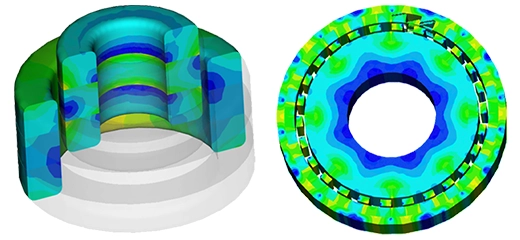Wireless power transfer (WPT) systems stand at the forefront of innovation, offering transformative solutions for powering everything from medical implants to electric vehicles. Recent research explores WPT's capabilities and challenges, particularly focusing on pacemaker and EV charger systems. This comprehensive analysis sheds light on WPT's vast potential across various sectors, while addressing key challenges including air gap distances, alignment precision, electromagnetic interference, and heat management. Through such investigations, there is a concerted effort to push the boundaries of WPT technology, aiming to enhance its efficiency, reliability, and practical applicability.
Unveiling the Challenges
A series of virtual experiments, conducted by EMWorks-EMS, revolve around two pivotal models. The first model delineates a WPT system designed specifically for a pacemaker, as illustrated in Figure 1. Conversely, the second model is dedicated to a WPT system for an Electric Vehicle (EV) charger, showcased in Figure 2. These simulations, grounded in precise engineering and scientific inquiry, aim to push the boundaries of WPT technology, addressing its application in both life-saving medical devices and the rapidly evolving electric vehicle industry.
Figure 1: 3D Model of WPT Design used in a Pacemaker
Figure 2: 3D Design of Bipolar Pad for WPT EV Charger
These experiments illuminate pivotal challenges inherent in wireless power transfer technology, notably the influence of air gap distances and alignment precision on charging efficiency. Additionally, they explore the potential for electromagnetic interference, a significant concern in the seamless operation of such systems. Furthermore, the experiments delve into the quest for optimal heat management, a critical factor in ensuring the reliability and safety of wireless charging solutions. Through these investigations, we gain deeper insights into enhancing the performance and practicality of wireless power technologies.
Impact of Air Gap and Alignment Variations on Magnetic Flux Distribution
To assess the impact of air gap distances and alignment discrepancies on magnetic flux distribution, a parametric AC Magnetic analysis is employed. The ensuing animated plots, in Figures 3-5, vividly illustrate how variations in magnetic flux density unfold across different scenarios, providing a visual representation of these effects.
Figure 3: Animated Visualization of Magnetic Flux Variation with Air Gap Distance
Figure 4. Animated Visualization of Magnetic Flux Variation with Lateral Misalignment
Figure 5: Animated Visualization of Magnetic Flux Variation with Angular Misalignment
Impact of Air Gap on Inductance, Resistance, and Coupling Efficiency
The observations from Figures 6-8, indicating a significant relationship between air gap distance and key design parameters such as the critical coupling coefficient and mutual inductance, have profound implications for WPT systems. As the air gap distance increases, both the critical coupling coefficient and mutual inductance decrease, which can directly impact the efficiency and effectiveness of energy transfer in WPT applications.
1. Reduced Efficiency: The decrease in mutual inductance with larger air gaps leads to reduced energy transfer efficiency. This is because mutual inductance is a measure of how effectively a magnetic field can induce an electrical current in a secondary coil. A lower mutual inductance means that less energy is transferred from the primary to the secondary coil, requiring more power to achieve the same level of charging or energy transfer.
2. Design Limitations: The inverse relationship between the air gap distance and the critical coupling coefficient imposes design constraints on WPT systems. It suggests that to maintain efficient energy transfer, devices must be designed to operate within a relatively small air gap distance. This limitation can affect the usability and applicability of WPT technology in scenarios where a larger air gap is necessary or unavoidable, such as in certain types of electric vehicle charging or industrial applications.
3. Optimization Challenges: Achieving optimal performance in WPT systems becomes more challenging as the air gap distance increases. Designers must balance the need for efficient energy transfer with the physical and practical limitations of their application, potentially requiring more complex or costly solutions, such as advanced coil designs or higher frequencies, to compensate for the reduced coupling coefficient and mutual inductance.
4. Impact on Safety and Standards: The need to keep air gap distances minimal for efficiency reasons may also influence safety standards and regulations, as closer proximity between transmitter and receiver components could raise concerns about electromagnetic exposure, especially in applications involving human interaction.
In summary, the relationship between air gap distance and key design parameters underscores the importance of careful design and optimization in the development of WPT systems, with a focus on minimizing air gap distances where possible to maximize efficiency and performance.
Figure 6: Variation of Self and Mutual Inductances with Air Gap Distance
Figure 7: AC Resistance Variation in Relation to Air Gap Distance
Figure 8: Variation of Coupling Coefficient with Air Gap Distance
The Critical Role of Operating Frequency
The operating frequency of a WPT system is a pivotal factor that affects its efficiency, range, component size, and compatibility with existing standards and devices. While higher frequencies can lead to increased energy losses and reduced transmission distances, they allow for smaller, more compact system designs. Conversely, lower frequencies can facilitate longer-range power transfers but require larger components, making the system bulkier. Therefore, selecting an optimal frequency is a delicate balance that involves minimizing interference, adhering to regulatory standards, and optimizing the trade-off between performance and practicality. The evaluation of the operating frequency's influence on the system's efficiency was conducted through a parametric AC Magnetic analysis coupled with circuit simulations, revealing critical insights into how frequency choices impact overall system behavior as shown Figure 9-10.
Figure 9: Input and Output Power versus Frequency
Figure 10: Power Efficiency versus Frequency
Heat and Loss Analyses
An examination of the loss quantities generated within the studied WPT devices facilitated the computation and visualization of various loss distributions. These distributions were observed in the aluminum shielding, ferrite bars, and copper coils of the device. This analysis is crucial for understanding the thermal behavior of WPT systems and for optimizing their design to minimize losses and enhance efficiency. Figure 11-13 depict the results obtained.
Figure 11: Solid Loss Distribution in the Aluminum Shield
Figure 12: Core Loss Distribution in the Ferrite Support
Figure 13: Winding Loss Distribution in the Coils
The comprehensive loss calculations enabled the assessment of temperature distribution across the entire Wireless Power Transfer (WPT) system, revealing a maximum steady-state temperature of 67°C, as shown in Figure 14-15.
Figure 14: Temperature Distribution across the WPT System
Figure 15: Temperature Variation versus Time
Key Design Considerations for Advancing WPT Technology
The exploration into WPT systems has illuminated key design considerations critical for the advancement of this technology. Here are the condensed design lessons learned:
1. Alignment and Air Gap Precision: Achieving precise alignment and managing air gap distances are essential for maximizing energy transfer efficiency. This precision impacts the performance of WPT systems across various applications, from medical devices to EV charging.
2. Electromagnetic Interference Management: The need to mitigate electromagnetic interference is crucial. Design strategies must include robust EMI management to ensure that WPT systems can coexist with other electronic devices without causing disruptions.
3. Operating Frequency: The operating frequency has a significant impact on WPT system performance, including efficiency and component size. An optimal frequency choice is crucial, as it influences energy transfer characteristics and system design, necessitating a balance between minimizing losses and meeting practical design constraints.
3. Effective Heat Management: Addressing heat generation within WPT systems is vital for their longevity and safety. Implementing effective cooling solutions and thermal management strategies is necessary to manage heat distribution and dissipation.
4. Flexibility in Operating Conditions: WPT systems should be versatile, capable of maintaining high efficiency across varying air gaps and alignment scenarios. This adaptability is essential for their practical application in diverse environments.
By focusing on these design principles, the future of WPT technology looks promising, poised to offer efficient, reliable, and seamlessly integrated wireless charging solutions across a wide range of applications.



